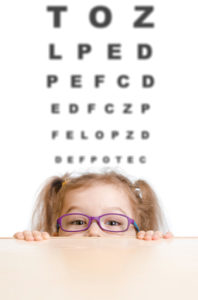At least once or twice a month, I see patients well into their thirties, and even forties, who inform me that they have never had an eye examination. They claim that their vision has always been very good, and that they have had no need for a comprehensive examination. They are also very surprised to walk out of our office a week or two later with their new glasses—and can’t believe what they have been missing! Many wonder, How long have I been struggling to see? Could I have performed better as a child in school, and even sports?
The school years are a very important time in every child’s life. All parents want to see their children do well in school, and most parents do all they can to provide them with the best educational opportunities. However, too often, one important learning tool may be overlooked—a child’s vision.
It has been estimated that as much as 80% of the learning a child does occurs through his or her eyes…(read the rest of the story)
Written by: Dr. Chad Rigtrup
Originally published on Utah Valley Health and Wellness
It was December of 2010. I was sitting on a training table inside Lucas Oil Stadium in Indianapolis, making a phone call to my wife. She had given birth to our first child a few days earlier, and I was calling to reassure her that everything was alright. It was one of the last games of the season, and our second meeting with the Jacksonville Jaguars. The only thing I recall about the incident was getting ready to catch the ball, and then being face down in the turf with the Colts’ training staff around me. It was an all too familiar scene to the first concussion I had received, just a month and a half before, in Philadelphia. While sitting on that training table, it was pretty clear that I wouldn’t be finishing out the remainder of the 2010-11 season with the Colts.
During the next week I would go through the NFL’s concussion protocol, getting a standard MRI, seeing an independent neurologist, and eventually being told to just “take it easy” during the off-season. One common trait almost all professional athletes share is our desire to identify any weaknesses we may have, and make sure those weaknesses become strengths.
Naturally, my first priority during the off-season was getting my concussions dealt with and decreasing the possible long-term effects. Just resting and hoping it didn’t happen again didn’t sit well with me. For every other injury I had experienced throughout my career, I was told precisely what areas were affected by the injury, and was given an active rehabilitation protocol. This allowed me to strengthen the area affected in order to eliminate any overcompensation or chance of re-injury. It didn’t make sense to me why I wouldn’t take the same approach with the injuries my brain sustained…(read the rest of the story)
Written by: Austin Collie
Originally published on Utah Valley Health and Wellness
Photography by Mark A. Philbrick, Copyright BYU Photo 2007, All Rights Reserved
Fall is a special time of year. It’s cool, but not cold, the colors are popping on the trees, and the smell of fall sports is in the air! There are many things you can do before and during the season to perform your best and avoid injury.
First, get some sleep! Student athletes need 8-10 hours of sleep per night to recharge their muscle batteries, otherwise the muscles stay tight and tired, and aren’t able to recover from the previous day’s practice or game. Next thing you know, you just pulled a muscle. Go to bed early and beat your opponent!
Second, eat right. Avoid soda or candy, and try to limit red meat and packaged food. Go to the fish and vegetables like the pros do! Your body will feel stronger, and you’ll have the right fuel to keep your energy up and keep you going all day long.
Third…(read the rest of the story)
Written by: Dr. Eric Brady, DC, DACBSP, Board Certified Sports Physician
Originally published on Utah Valley Health and Wellness
As a scientist who studies concussion and does research on concussion treatment, I was recently asked what I would do if I needed concussion treatment. What questions would I ask, from my perspective as an expert? To answer this, my questions would focus on what I see as the four components of successful concussion recovery—diagnosis, assessment, treatment, and maintenance.
Diagnosis
How will my concussion be diagnosed? How will my concussion symptoms be distinguished from other potential health issues that might cause similar symptoms?
I would want to know what kind of health professional is best able to find answers to these preliminary questions, and what diagnostic tests will be used. A family doctor will typically be able to help get this process started and should refer you to a neuropsychologist, in the opinion of most concussion research experts. Among the tools that neuropsychologists use, a Functional Neurocognitive Imaging (fNCI) test is ideal. This is a type of MRI brain scan that can detect problems in brain functioning caused by concussion.
Assessment
After determining what my symptoms are, I would want to know exactly which parts of my brain have been affected, how that relates to the symptoms I am currently experiencing, and how my treatment will help my particular brain injury. A neuropsychologist, especially one who can use and interpret fNCI brain scanning, is usually best suited to do this assessment. In order for an assessment to be truly useful, it needs to go beyond being simply “informative” and give you and your medical providers a clear treatment plan for your individual rehabilitation program.
Treatment
Although post-concussion symptoms can vary widely from person to person, there are four general categories that scientists and doctors use to group common symptoms:…(read the rest of the story)
Originally published on Utah Valley Health and Wellness
Written by: Dr. Mark D. Allen
Does your smile light up the room? If not, you may want to consider adding a silver lining to your smile. This article discusses the benefits of orthodontics, more commonly known as braces!
Why Braces are Important
For most people, a beautiful smile is the most obvious benefit of braces. However, it is important to consider some of the other benefits of orthodontics.
Improved Oral Health
Straight teeth contribute to healthy teeth and gums. Straight teeth decrease your chances of tooth decay and cavities. The gums are healthier, too, and therefore you are less likely to develop periodontal (gum) disease. Not only will you have a great smile, you will keep your beautiful smile!
Enhanced Self-Esteem
An attractive smile is a wonderful asset. It contributes to self-esteem, self-confidence and self-image. These are important qualities at every age. A pleasing appearance is a vital component of self-confidence. A person’s self-esteem often improves as orthodontic treatment brings everything into proportion. In this way, orthodontic treatment can benefit social and career success. It may also improve a person’s general attitude toward life. Behind every smile is a unique and important individual.
Comfortable Bite
Along with the straight teeth comes an improved and comfortable bite. Various bite problems can cause excessive wear of your teeth and possible jaw joint problems. The American Association of Orthodontists explains, “Straight teeth help an individual to effectively bite, chew, and speak.”
How Braces Work
When your orthodontist attaches the brackets, archwire (the silver lining) and other orthodontic material in your mouth, he/she is beginning to build your new smile. Since the brackets are affixed to your teeth, the teeth move gradually when the archwire puts pressure on the brackets. The archwire is very important, since your teeth will eventually follow the shape of the archwire. When braces put pressure on your teeth, your teeth are actually getting loosened and repositioned where they should be. Once they’re in the right spots, the braces hold them there as bone tissue in your jaw grows back in so your new smile will stay in place. Technically, this is a biomechanical process called bone remodeling. It is pretty serious stuff!
Clear Removable Braces
Clear, removable aligner systems are ideal for adults or teens that would prefer to not wear braces. Invisalign doesn’t use wires or metal brackets, but rather uses series of custom clear, removable, aligners that straighten your teeth. This is simply a less noticeable approach to straightening your teeth and experiencing the benefits of a great smile.
Braces for Children
The American Association of Orthodontists recommends that every child have an orthodontic evaluation by age 7. Although treatment may not begin at this young age, an early examination allows your orthodontist to monitor your child’s development. Early detection can significantly reduce removal of permanent teeth. In many cases, positive orthodontic results can be achieved, which would not otherwise be possible once the face and jaw have finished growing.
Braces For Adults
Braces aren’t just for kids! More and more adults are…(read the rest of the story)
Originally published on Utah Valley Health and Wellness
Written by: Dr. Casey R. Warren
May is Skin Cancer Awareness Month. Though skin cancer can be scary, it is also one of the most preventable forms of cancer. With summertime approaching, and more exposure to the sun’s harmful effects, we’ve put together a few guidelines to help you reduce your risk of skin cancer while you’re out enjoying the summer sun:
Explore Medical Grade Sunscreen/Sunblock
The majority of skin cancer cases are due to ultraviolet damage from sunburns. Medical spas, dermatologists and some plastic surgeons may carry, in their office, an advanced medical grade sunblock, offered in SPFs of 30 or higher.
There are now better formulated broad-spectrum protection sunblock offered to consumers. Better technologies and the use of nanotechnology offer new elegance and efficacy to well-known broad-spectrum sunblock ingredients, zinc oxide and titanium dioxide. Zinc oxide and titanium oxide are the two best ingredients for a broad-spectrum sunblock. They are used by SkinCeuticals, Obagi, SkinMedica and other doctor recommended skin care lines. It’s not new science, and the better formulations now have the micronized particles so they don’t leave that weird, white residue on the skin.
Optimize Healthy Effects of Sun Exposure
While you certainly need to avoid the skin damage associated with sunburn, sun exposure is required for optimal health. Renowned physician and best-selling author Dr. Joseph Mercola tells us: “If you accept the essential nature of UV light, then you can conclude that safe exposure to sunshine is possible by understanding your skin type, the UV strength at the time of exposure, and your duration of exposure. My advice has been clear: Always avoid sunburn.”
Darker-skinned people not only need more sun exposure to produce sufficient amounts of vitamin D, they’re also more protected from skin cancer due to their skin pigmentation. Yet, this important reality is simply ignored by dermatologists, resulting in most African Americans being at a radically increased risk of cancers and heart disease from vitamin D deficiency.
The following excerpts are taken from Dr. Mercola’s website (www.mercola.com):
”How the sun affects you depends on your complexion, the shade of which is determined by melanin … The anti-oxidizing molecule is so versatile at protecting and repairing DNA from UV solar radiation that creatures from humans to fungi deploy it … [T]he melanin sits atop cellular DNA like tiny umbrellas pointed … out to shield from incoming rays …
[T]he same ultraviolet wavelengths in the 290 to 400 nanometers range that trigger melanin production also spark vitamin D creation. You cannot make one without the other.
Humans evolved to produce two kinds of melanin … The MC1R gene determines the type of melanin the body produces. In the mid-zone such as the Mediterranean region, people … produce eumelanin, the pigment responsible for brown or black hair and for dark skin that tans easily …
[I]n far northern Europe, humans paled, adapting to lower light … with a different type of melanin, called pheomelanin, associated with fair skin and blonde and red hair with minimal protective value, but allowing more UV to penetrate to make vitamin D. ”
Caution with Mid-Day Sun
Mid-day is associated with the strongest sun rays. In North America the sun’s rays are strongest from 10:00 to 4:00. Depending on skin type, we can safely expose ourselves to the sun for 5 to 20 minutes before applying sunblock. Protective clothing, a broad rimed hat, and sunglasses can also be used to prevent UVA and UVB rays from having access to your skin…(read the rest of the story)
Originally published on Utah Valley Health and Wellness
Dental caries, or tooth decay, is the number one chronic infectious disease affecting children in the United States. When bacteria has access to sugars, it produces acid that breaks down teeth, forming cavities.
Although it is a common and destructive disease, dental caries is highly preventable. The best prevention is aggressive daily oral hygiene. The American Academy of Pediatric Dentistry (AAPD) recommends that children brush their teeth every morning and every night. They should be supervised and assisted by their parents until they are at least eight years old. Children should also floss daily, beginning as early as two years old.
A child’s diet plays a large role in dental cavities, and therefore the prevention of cavities. It is a common understanding that sugar is the source of energy for cavity-creating bacteria. What most people forget is that a lot of “healthy foods” contain natural sugars that can be broken down and used by bacteria. Here are a couple of helpful hints to follow:
- The stickier the snack or treat, the harder on the teeth
- It’s not how much sugar they get but how often they get it—meaning avoid snacking throughout the day, and especially bottles or sippy cups through the night.
These are a lot of “what not to do’s.” Some “to do’s” are:
Drink lots of water. Water is the only liquid that doesn’t have the potential to cause cavities. It can also help “wash” the teeth throughout the day when you don’t have access to brushing after each snack or meal.
Snack smart. Vegetables are healthy snacks that don’t have a lot of natural sugars. We can’t expect children to never eat candy, but it’s important to limit the types and frequency…(read the rest of the story)
Originally published on Utah Valley Health and Wellness
 If you suffer from headaches, you are not alone. 45 million Americans are suffering with you. Because so many experience headaches, many think it’s normal—but it’s not. It is not natural to have headaches daily, or even three to four times a week. Nor is it typical to take headache medication on a daily basis just to prevent or minimize the intensity of your pain. Standard headache sufferers experience headaches two to three times per year, each lasting about three to four hours. If you endure headaches more frequently than this, something is wrong.
If you suffer from headaches, you are not alone. 45 million Americans are suffering with you. Because so many experience headaches, many think it’s normal—but it’s not. It is not natural to have headaches daily, or even three to four times a week. Nor is it typical to take headache medication on a daily basis just to prevent or minimize the intensity of your pain. Standard headache sufferers experience headaches two to three times per year, each lasting about three to four hours. If you endure headaches more frequently than this, something is wrong.
The most common type of headache is a tension headache. This type of headache is not caused by a disease or serious pathology, but is due to trauma or poor posture that causes your upper vertebra and muscles to compress or irritate a nerve that starts at the base of your skull and goes right above your eye.
Knowing that the majority of headaches stem from these things means that there are actions you can take to limit the tension and decrease the time you spend suffering. Muscle tension headaches can often be avoided by maintaining proper posture and neck movements while performing your normal activities.
What Can You Do?…(read the rest of the story)
Originally published on Utah Valley Health and Wellness




